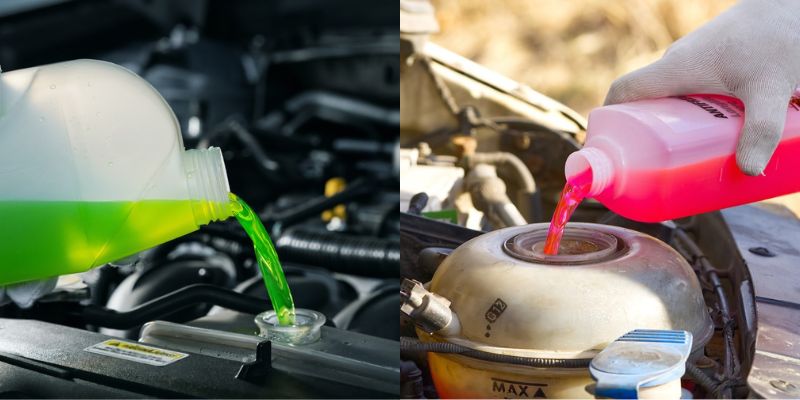Antifreeze, also known as engine coolant, is a liquid solution that primarily consists of ethylene glycol or propylene glycol mixed with water.
It serves multiple purposes, such as preventing the engine from freezing in cold temperatures, raising the boiling point of the coolant, and protecting the engine against corrosion.
In this article, we will explore how can you mix orange and green antifreeze and what are the risks of mixing green and orange coolants.
Can you mix orange and green antifreeze?
No, it is not recommended to mix orange and green antifreeze. Mixing different types can lead to chemical reactions, reducing effectiveness and potentially causing damage to the cooling system.
Orange Antifreeze
Orange antifreeze, often referred to as extended-life antifreeze or Dex-Cool is typically used in General Motors (GM) vehicles.
It contains organic acid technology (OAT) additives that provide superior protection against corrosion, even in high-stress conditions. Orange antifreeze is recognized by its bright orange or reddish color.
Green Antifreeze
Green antifreeze, also known as conventional or ethylene glycol antifreeze, is the traditional type widely used in various vehicles.
It contains inorganic additives like silicates, phosphates, and borates, which offer excellent protection against corrosion and cavitation. Green antifreeze has a characteristic green color.
Compatibility of Orange and Green Antifreeze
Corrosion Protection
With its organic acid technology (OAT) additives, Orange Antifreeze offers excellent corrosion protection for modern engine materials such as aluminum and aluminum alloys.
The OAT additives create a protective layer on the surfaces, preventing corrosion and extending the life of engine components.
Compatibility with Older Engines
Green antifreeze, with its inorganic additives, is a well-suited coolant for older engines that contain brass, copper, or soldered components.
The inorganic additives in green antifreeze provide effective protection against corrosion specific to these materials.
Freeze Protection
Both orange and green antifreeze protect against freezing in cold temperatures. However, the freeze point protection varies between the two types.
Orange antifreeze typically offers a lower freeze point, making it more suitable for extremely cold climates.
Green antifreeze, though effective in most regions, may require additional concentration or a supplemental coolant additive in very low-temperature environments.
Boil Over Protection
Both orange and green antifreeze protect against boiling over in hot conditions.
The boiling point protection is generally similar for both types, ensuring optimal engine performance in various weather conditions.
Risks of Mixing Orange and Green Antifreeze
a) Chemical Incompatibility
Mixing orange and green antifreeze can lead to the formation of sludge or gel-like substances, which can clog the radiator, heater core, and coolant passages.
This can impede the flow of coolant and cause overheating, leading to potential engine damage.
b) Corrosion and Cavitation
Orange and green antifreeze have different corrosion inhibitors. Mixing them can disrupt the balance of these inhibitors, leaving the cooling system vulnerable to corrosion and cavitation.
Over time, this can lead to coolant leaks, component failure, and reduced engine performance.
c) Reduced Freeze and Boil Protection
Different antifreeze formulations offer various levels of freeze and boil protection.
Mixing orange and green antifreeze can dilute the effectiveness of these properties, potentially leaving the engine susceptible to freezing in cold temperatures or boiling over in hot conditions.
What to do if accidentally mix orange and green coolant?
If orange and green antifreeze have accidentally been mixed, it is important to address the situation promptly to minimize potential risks and damage to the cooling system.
Here are the steps to follow if orange and green antifreeze get mixed:
1. Stop Using the Mixed Coolant:
Once you realize that the antifreeze has been mixed, it is advisable to immediately stop using the coolant mixture in your vehicle.
Continuing to run the engine with mixed antifreeze can exacerbate any potential issues and may lead to further damage.
2. Drain and Flush the Cooling System:
To rectify the situation, the cooling system needs to be thoroughly drained and flushed. Start by locating the drain plug on the radiator and placing a suitable container underneath to catch the coolant.
Open the drain plug and allow the mixed coolant to drain completely. Once drained, close the drain plug.
Next, refill the cooling system with clean water and run the engine for a few minutes to circulate the water.
Then, repeat the draining process to flush out any remaining traces of the mixed coolant. Repeat this process until the drained water appears clear and free of any coloration.
3. Refill with the Correct Antifreeze
After flushing the cooling system, it is crucial to refill it with the appropriate type and color of antifreeze recommended by the vehicle manufacturer.
Refer to the owner’s manual or contact the manufacturer directly for specific guidance on the correct antifreeze to use in your vehicle.
4. Bleed Air from the System
Once the cooling system is refilled with the correct antifreeze, it is important to bleed any trapped air from the system.
Air pockets can hinder proper coolant circulation and lead to overheating. Consult the vehicle’s owner’s manual for instructions on properly bleed the air from the cooling system.
5. Monitor Coolant Levels and System Performance
After completing the steps mentioned above, regularly monitor the coolant levels and observe the system’s performance. Keep an eye out for any signs of coolant leaks, abnormal temperature readings, or other cooling system issues.
If you notice any problems, it is advisable to consult a professional mechanic for further assessment and necessary repairs.
Remember, prevention is always better than trying to resolve a problem after it occurs.
To avoid mixing antifreeze types in the future, be mindful when adding coolant and ensure that you are using the recommended antifreeze for your specific vehicle.
Frequently Asked Questions (FAQs)
Can I mix orange and green antifreeze in an emergency?
It is not recommended to mix orange and green antifreeze, even in emergencies. If you find yourself in a coolant-related emergency, it is best to use distilled water as a temporary solution until you can flush and refill the cooling system with the appropriate antifreeze for your vehicle.
Can mixing orange and green antifreeze cause engine damage?
Yes, mixing orange and green antifreeze can cause engine damage. The chemical reactions and incompatibilities between the two can lead to the formation of sludge, milky coolant, corrosion, and reduced coolant effectiveness.
It is essential to use the proper antifreeze for your vehicle to maintain optimal engine performance and longevity.
How can I determine the type of antifreeze in my vehicle?
To determine the type of antifreeze in your vehicle, consult your vehicle’s owner’s manual or contact the manufacturer.
They can provide specific information regarding the recommended antifreeze type and color for your vehicle’s make and model.
Conclusion
In conclusion, it is not advisable to mix orange and green antifreeze due to their differing additive formulations and potential risks.
Mixing these two types can lead to chemical reactions, sludge formation, corrosion, and reduced coolant effectiveness.
To ensure the longevity and performance of your vehicle’s cooling system, it is crucial to use the recommended antifreeze type and color specified by the manufacturer.

Joseph Morgan has decades of automotive experience. The Detroit native started restoring classics in the 1970s. He owned a vintage repair shop and authored articles for car magazines. With a 1965 Mustang fastback of his own, Joseph now shares advice through his YouTube channel. From engine swaps to rust repair, his expertise helps preserve automotive history.
